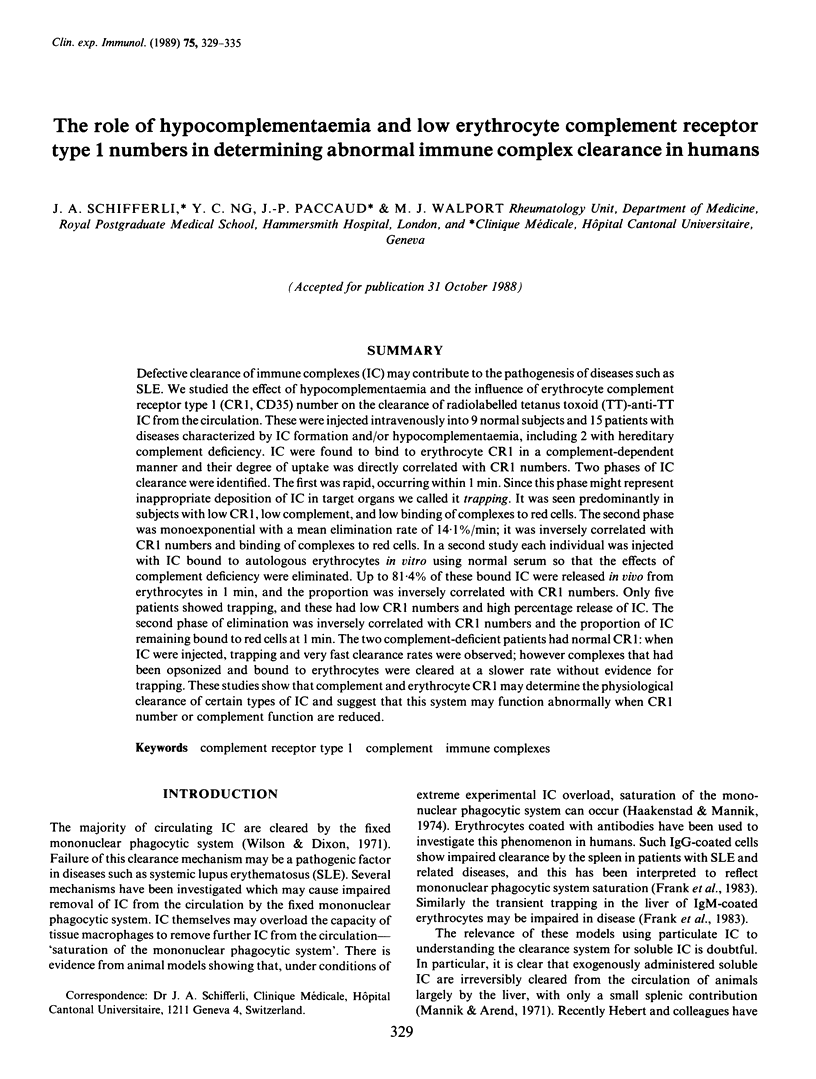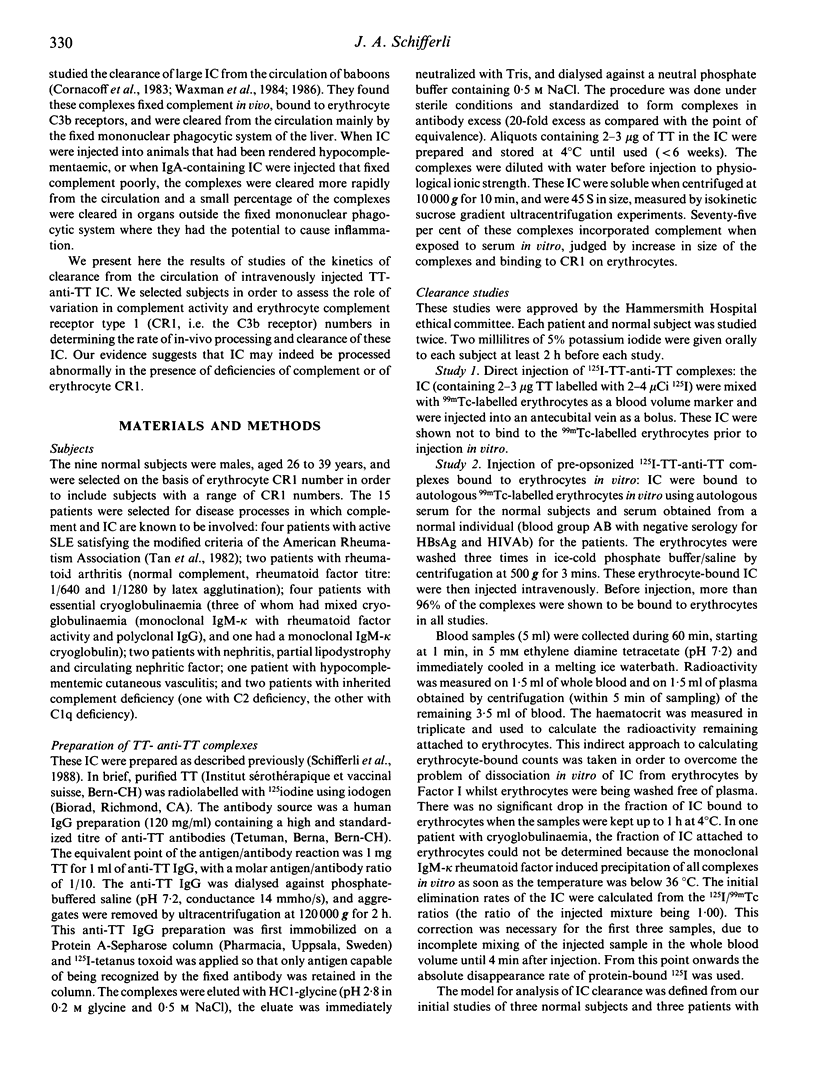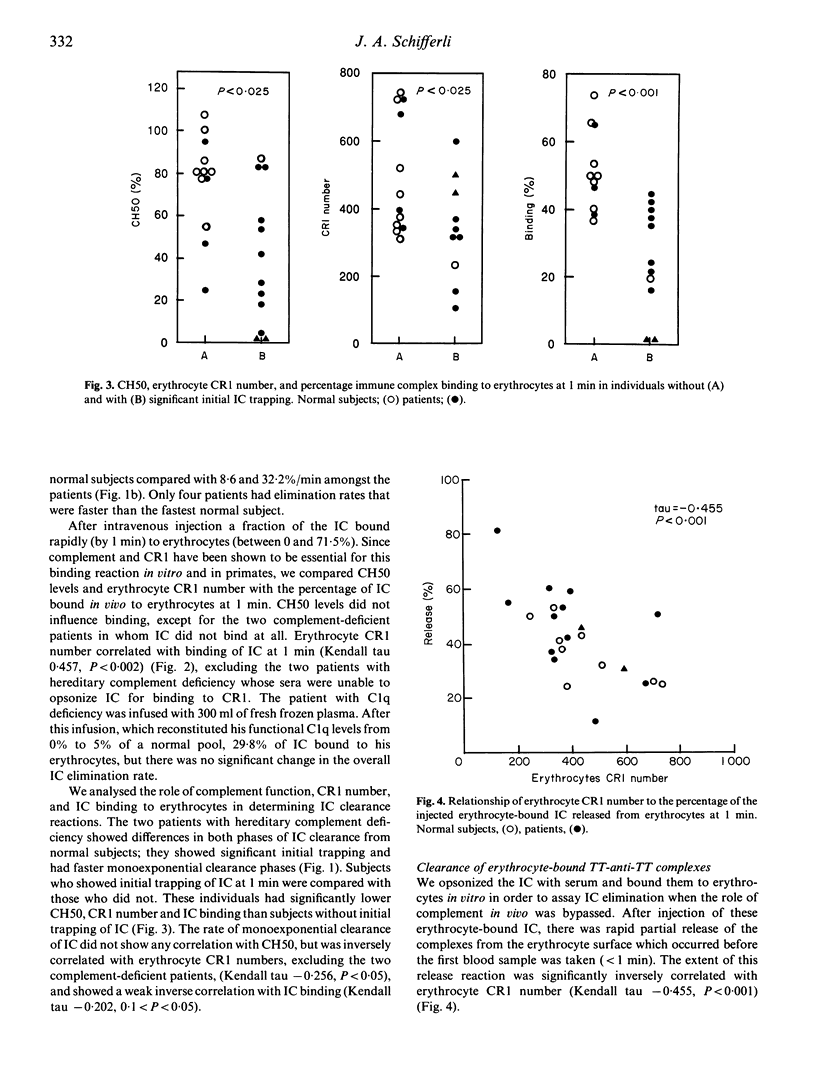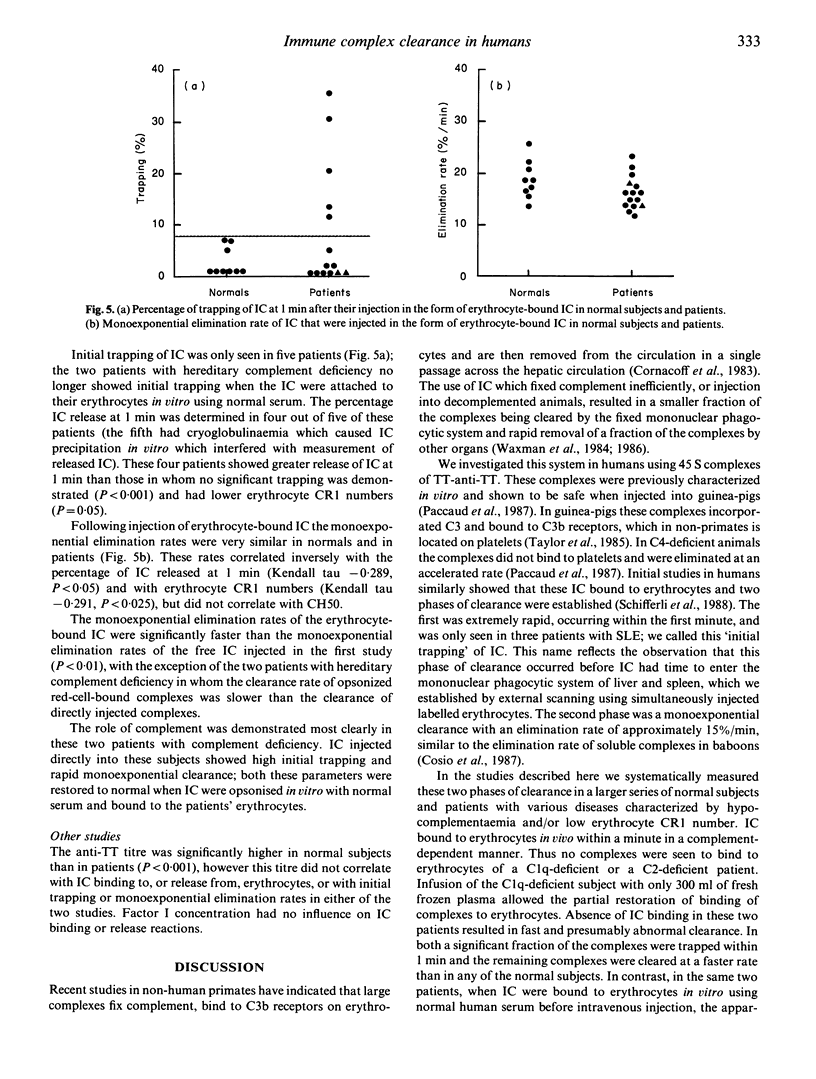Abstract
Defective clearance of immune complexes (IC) may contribute to the pathogenesis of diseases such as SLE. We studied the effect of hypocomplementaemia and the influence of erythrocyte complement receptor type 1 (CR1, CD35) number on the clearance of radiolabelled tetanus toxoid (TT)-anti-TT IC from the circulation. These were injected intravenously into 9 normal subjects and 15 patients with diseases characterized by IC formation and/or hypocomplementemia, including 2 with hereditary complement deficiency. IC were found to bind to erythrocyte CR1 in a complement-dependent manner and their degree of uptake was directly correlated with CR1 numbers. Two phases of IC clearance were identified. The first was rapid, occurring within 1 min. Since this phase might represent inappropriate deposition of IC in target organs we called it trapping. It was seen predominantly in subjects with low CR1, low complement, and low binding of complexes to red cells. The second phase was monoexponential with a mean elimination rate of 14.1%/min; it was inversely correlated with CR1 numbers and binding of complexes to red cells. In a second study each individual was injected with IC bound to autologous erythrocytes in vitro using normal serum so that the effects of complement deficiency were eliminated. Up to 81.4% of these bound IC were released in vivo from erythrocytes in 1 min, and the proportion was inversely correlated with CR1 numbers. Only five patients showed trapping, and these had low CR1 numbers and high percentage release of IC. The second phase of elimination was inversely correlated with CR1 numbers and the proportion of IC remaining bound to red cells at 1 min. The two complement-deficient patients had normal CR1: when IC were injected, trapping and very fast clearance rates were observed; however complexes that had been opsonized and bound to erythrocytes were cleared at a slower rate without evidence for trapping. These studies show that complement and erythrocyte CR1 may determine the physiological clearance of certain types of IC and suggest that this system may function abnormally when CR1 number or complement function are reduced.
Full text
PDF






Selected References
These references are in PubMed. This may not be the complete list of references from this article.
- Cornacoff J. B., Hebert L. A., Smead W. L., VanAman M. E., Birmingham D. J., Waxman F. J. Primate erythrocyte-immune complex-clearing mechanism. J Clin Invest. 1983 Feb;71(2):236–247. doi: 10.1172/JCI110764. [DOI] [PMC free article] [PubMed] [Google Scholar]
- Cosio F. G., Hebert L. A., Birmingham D. J., Dorval B. L., Bakaletz A. P., Kujala G. A., Edberg J. C., Taylor R. P. Clearance of human antibody/DNA immune complexes and free DNA from the circulation of the nonhuman primate. Clin Immunol Immunopathol. 1987 Jan;42(1):1–9. doi: 10.1016/0090-1229(87)90167-x. [DOI] [PubMed] [Google Scholar]
- Edberg J. C., Kujala G. A., Taylor R. P. Rapid immune adherence reactivity of nascent, soluble antibody/DNA immune complexes in the circulation. J Immunol. 1987 Aug 15;139(4):1240–1244. [PubMed] [Google Scholar]
- Emlen W., Mannik M. Clearance of circulating DNA-anti-DNA immune complexes in mice. J Exp Med. 1982 Apr 1;155(4):1210–1215. doi: 10.1084/jem.155.4.1210. [DOI] [PMC free article] [PubMed] [Google Scholar]
- Finbloom D. S., Magilavy D. B., Harford J. B., Rifai A., Plotz P. H. Influence of antigen on immune complex behavior in mice. J Clin Invest. 1981 Jul;68(1):214–224. doi: 10.1172/JCI110238. [DOI] [PMC free article] [PubMed] [Google Scholar]
- Frank M. M., Lawley T. J., Hamburger M. I., Brown E. J. NIH Conference: Immunoglobulin G Fc receptor-mediated clearance in autoimmune diseases. Ann Intern Med. 1983 Feb;98(2):206–218. doi: 10.7326/0003-4819-98-2-218. [DOI] [PubMed] [Google Scholar]
- Haakenstad A. O., Mannik M. Saturation of the reticuloendothelial system with soluble immune complexes. J Immunol. 1974 May;112(5):1939–1948. [PubMed] [Google Scholar]
- Lachmann P. J., Walport M. J. Deficiency of the effector mechanisms of the immune response and autoimmunity. Ciba Found Symp. 1987;129:149–171. doi: 10.1002/9780470513484.ch11. [DOI] [PubMed] [Google Scholar]
- Lobatto S., Daha M. R., Breedveld F. C., Pauwels E. K., Evers-Schouten J. H., Voetman A. A., Cats A., Van Es L. A. Abnormal clearance of soluble aggregates of human immunoglobulin G in patients with systemic lupus erythematosus. Clin Exp Immunol. 1988 Apr;72(1):55–59. [PMC free article] [PubMed] [Google Scholar]
- Lobatto S., Daha M. R., Voetman A. A., Evers-Schouten J. H., Van Es A. A., Pauwels E. K., Van Es L. A. Clearance of soluble aggregates of human immunoglobulin G in healthy volunteers and chimpanzees. Clin Exp Immunol. 1987 Jul;69(1):133–141. [PMC free article] [PubMed] [Google Scholar]
- Ng Y. C., Schifferli J. A., Walport M. J. Immune complexes and erythrocyte CR1 (complement receptor type 1): effect of CR1 numbers on binding and release reactions. Clin Exp Immunol. 1988 Mar;71(3):481–485. [PMC free article] [PubMed] [Google Scholar]
- Paccaud J. P., Steiger G., Sjöholm A. G., Spaeth P. J., Schifferli J. A. Tetanus toxoid-anti-tetanus toxoid complexes: a potential model to study the complement transport system for immune complex in humans. Clin Exp Immunol. 1987 Aug;69(2):468–476. [PMC free article] [PubMed] [Google Scholar]
- Ross G. D., Yount W. J., Walport M. J., Winfield J. B., Parker C. J., Fuller C. R., Taylor R. P., Myones B. L., Lachmann P. J. Disease-associated loss of erythrocyte complement receptors (CR1, C3b receptors) in patients with systemic lupus erythematosus and other diseases involving autoantibodies and/or complement activation. J Immunol. 1985 Sep;135(3):2005–2014. [PubMed] [Google Scholar]
- Schifferli J. A., Ng Y. C., Estreicher J., Walport M. J. The clearance of tetanus toxoid/anti-tetanus toxoid immune complexes from the circulation of humans. Complement- and erythrocyte complement receptor 1-dependent mechanisms. J Immunol. 1988 Feb 1;140(3):899–904. [PubMed] [Google Scholar]
- Schifferli J. A., Ng Y. C., Peters D. K. The role of complement and its receptor in the elimination of immune complexes. N Engl J Med. 1986 Aug 21;315(8):488–495. doi: 10.1056/NEJM198608213150805. [DOI] [PubMed] [Google Scholar]
- Tan E. M., Cohen A. S., Fries J. F., Masi A. T., McShane D. J., Rothfield N. F., Schaller J. G., Talal N., Winchester R. J. The 1982 revised criteria for the classification of systemic lupus erythematosus. Arthritis Rheum. 1982 Nov;25(11):1271–1277. doi: 10.1002/art.1780251101. [DOI] [PubMed] [Google Scholar]
- Waxman F. J., Hebert L. A., Cornacoff J. B., VanAman M. E., Smead W. L., Kraut E. H., Birmingham D. J., Taguiam J. M. Complement depletion accelerates the clearance of immune complexes from the circulation of primates. J Clin Invest. 1984 Oct;74(4):1329–1340. doi: 10.1172/JCI111543. [DOI] [PMC free article] [PubMed] [Google Scholar]
- Waxman F. J., Hebert L. A., Cosio F. G., Smead W. L., VanAman M. E., Taguiam J. M., Birmingham D. J. Differential binding of immunoglobulin A and immunoglobulin G1 immune complexes to primate erythrocytes in vivo. Immunoglobulin A immune complexes bind less well to erythrocytes and are preferentially deposited in glomeruli. J Clin Invest. 1986 Jan;77(1):82–89. doi: 10.1172/JCI112306. [DOI] [PMC free article] [PubMed] [Google Scholar]


